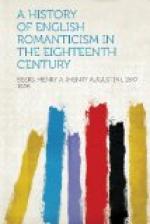Walter Scott, while yet a lad, made acquaintance with Ossian through Dr. Blacklock, and was at first delighted; but “the tawdry repetitions of the Ossianic phraseology,” he confesses, “disgusted me rather sooner than might have been expected from my age.” He afterward contributed an essay on the authenticity of the poems to the proceedings of the Speculative Club of Edinburgh. In one sense of the word Scott was the most romantic of romanticists; but in another sense he was very little romantic, and there was not much in his sane, cheerful, and robust nature upon which such poetry as Ossian could fasten.[31] It is just at this point, indeed, that definitions diverge and the two streams of romantic tendency part company. These Carlyle has called “Wertherism” and “Goetzism"[32] i.e. sentimentalism and mediaevalism, though so mild a word as sentimentalism fails to express adequately the morbid despair to which “Werther” gave utterance, and has associations with works of a very different kind, such as the fictions of Richardson and Sterne. In England, Scott became the foremost representative of “Goetzism,” and Byron of “Wertherism.” The pessimistic, sardonic heroes of “Manfred,” “Childe Harold,” and “The Corsair” were the latest results of the “Il Penseroso” literature, and their melodramatic excesses already foretokened a reaction.
Among other testimonies to Ossian’s popularity in England are the numerous experiments at versifying MacPherson’s prose. These were not over-successful and only a few of them require mention here. The Rev. John Wodrow, a Scotch minister, “attempted” “Carthon,” “The Death of Cuthullin” and “Darthula” in heroic couplets, in 1769; and “Fingal” in 1771. In the preface to his “Fingal,” he maintained that there was no reasonable doubt of the antiquity and authenticity of MacPherson’s “Ossian.” “Fingal”—which seems to have been the favorite—was again turned into heroic couplets by Ewen Cameron, in 1776, prefaced by the attestations of a number of Highland gentlemen to the genuineness of the originals; and by an argumentative introduction, in which the author quotes Dr. Blair’s dictum that Ossian was the equal of Homer and Vergil “in strength of imagination, in grandeur of sentiment, and in native majesty of passion.” National pride enlisted most of the Scotch scholars on the affirmative side of the question, and made the authenticity of Ossian almost an article of belief. Wodrow’s heroics were merely respectable. The quality of Cameron’s may be guessed from a half dozen lines:
“When Moran, one commissioned
to explore
The distant seas, came running
from the shore
And thus exclaimed—’Cuthullin,
rise! The ships
Of snowy Lochlin hide the
rolling deeps.
Innumerable foes the land
invade,
And Swaran seems determined
to succeed.’”
Whatever impressiveness belonged to MacPherson’s cadenced prose was lost in these metrical versions, which furnish a perfect reductio ad absurdum of the critical folly that compared Ossian with Homer. Homer could not be put in any dress through which the beauty and interest of the original would not appear. Still again, in 1786, “Fingal” was done into heroics by a Mr. R. Hole, who varied his measures with occasional ballad stanzas, thus:




